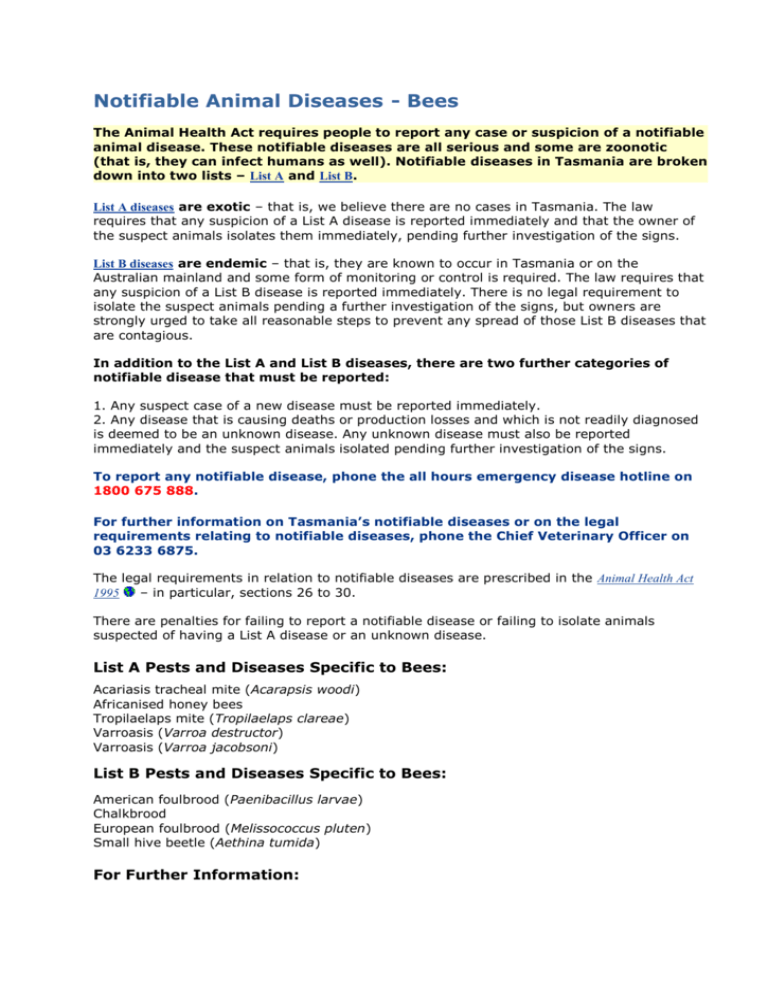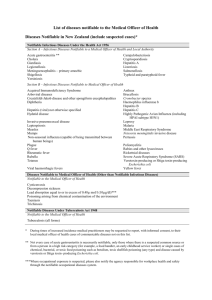Notifiable Animal Diseases
advertisement

Notifiable Animal Diseases - Bees The Animal Health Act requires people to report any case or suspicion of a notifiable animal disease. These notifiable diseases are all serious and some are zoonotic (that is, they can infect humans as well). Notifiable diseases in Tasmania are broken down into two lists – List A and List B. List A diseases are exotic – that is, we believe there are no cases in Tasmania. The law requires that any suspicion of a List A disease is reported immediately and that the owner of the suspect animals isolates them immediately, pending further investigation of the signs. List B diseases are endemic – that is, they are known to occur in Tasmania or on the Australian mainland and some form of monitoring or control is required. The law requires that any suspicion of a List B disease is reported immediately. There is no legal requirement to isolate the suspect animals pending a further investigation of the signs, but owners are strongly urged to take all reasonable steps to prevent any spread of those List B diseases that are contagious. In addition to the List A and List B diseases, there are two further categories of notifiable disease that must be reported: 1. Any suspect case of a new disease must be reported immediately. 2. Any disease that is causing deaths or production losses and which is not readily diagnosed is deemed to be an unknown disease. Any unknown disease must also be reported immediately and the suspect animals isolated pending further investigation of the signs. To report any notifiable disease, phone the all hours emergency disease hotline on 1800 675 888. For further information on Tasmania’s notifiable diseases or on the legal requirements relating to notifiable diseases, phone the Chief Veterinary Officer on 03 6233 6875. The legal requirements in relation to notifiable diseases are prescribed in the Animal Health Act 1995 – in particular, sections 26 to 30. There are penalties for failing to report a notifiable disease or failing to isolate animals suspected of having a List A disease or an unknown disease. List A Pests and Diseases Specific to Bees: Acariasis tracheal mite (Acarapsis woodi) Africanised honey bees Tropilaelaps mite (Tropilaelaps clareae) Varroasis (Varroa destructor) Varroasis (Varroa jacobsoni) List B Pests and Diseases Specific to Bees: American foulbrood (Paenibacillus larvae) Chalkbrood European foulbrood (Melissococcus pluten) Small hive beetle (Aethina tumida) For Further Information: Contact: Senior Veterinary Officer Bruce Jackson Snr Veterinary Officer 165 Westbury Road PROSPECT TAS 7250 Phone: 03 6336 5306 Fax: 03 6344 4961 Email: Bruce.Jackson@dpipwe.tas.gov.au Contact: Program Specialist Karla Williams Program Specialist 163-169 Main Road Moonah TAS 7009 Phone: (03) 6165 3778 Email: karla.williams@dpipwe.tas.gov.au Small Hive Beetle The Small Hive Beetle, Aethina tumida (Murray), has been present in some mainland States since 2002. It has not yet been detected in Tasmania. All beekeepers should inspect their hives for the presence of these beetles on a regular basis. There are species of native beetles that are similar to the Small Hive Beetle. If you are not certain what kind of beetle you have found, submit a sample. Details on how to collect samples, where to send them to and photographs of the beetle and larvae can be found on the Small Hive Beetle Surveillance web page. Small hive beetle larva Small hive beetle - adult dorsal view Division of Plant Industry, University of Florida Copyright: Jeffrey Lotz, Division of Plant Industry, Florida Department of Agriculture & Consumer Services The adult Small Hive Beetle are broad flattened beetles about 5-7 mm long and dark brown to nearly black in colour. Larvae are elongate white grubs. Pupae are white to brown and are found in soil beneath the hive. From egg to adult takes 38-81 days with five generations a year. Adults and larvae inhabit hives where they feed on stored honey and pollen. Combs are damaged and brood killed; honey ferments and bubbles out of the cells. Damage is so severe where this pest occurs in the Western Hemisphere that thousands of hives are killed by it each year. Further information on the Small Hive Beetle can be sourced on the NSW Agriculture website: www.agric.nsw.gov.au/smallhivebeetle.






